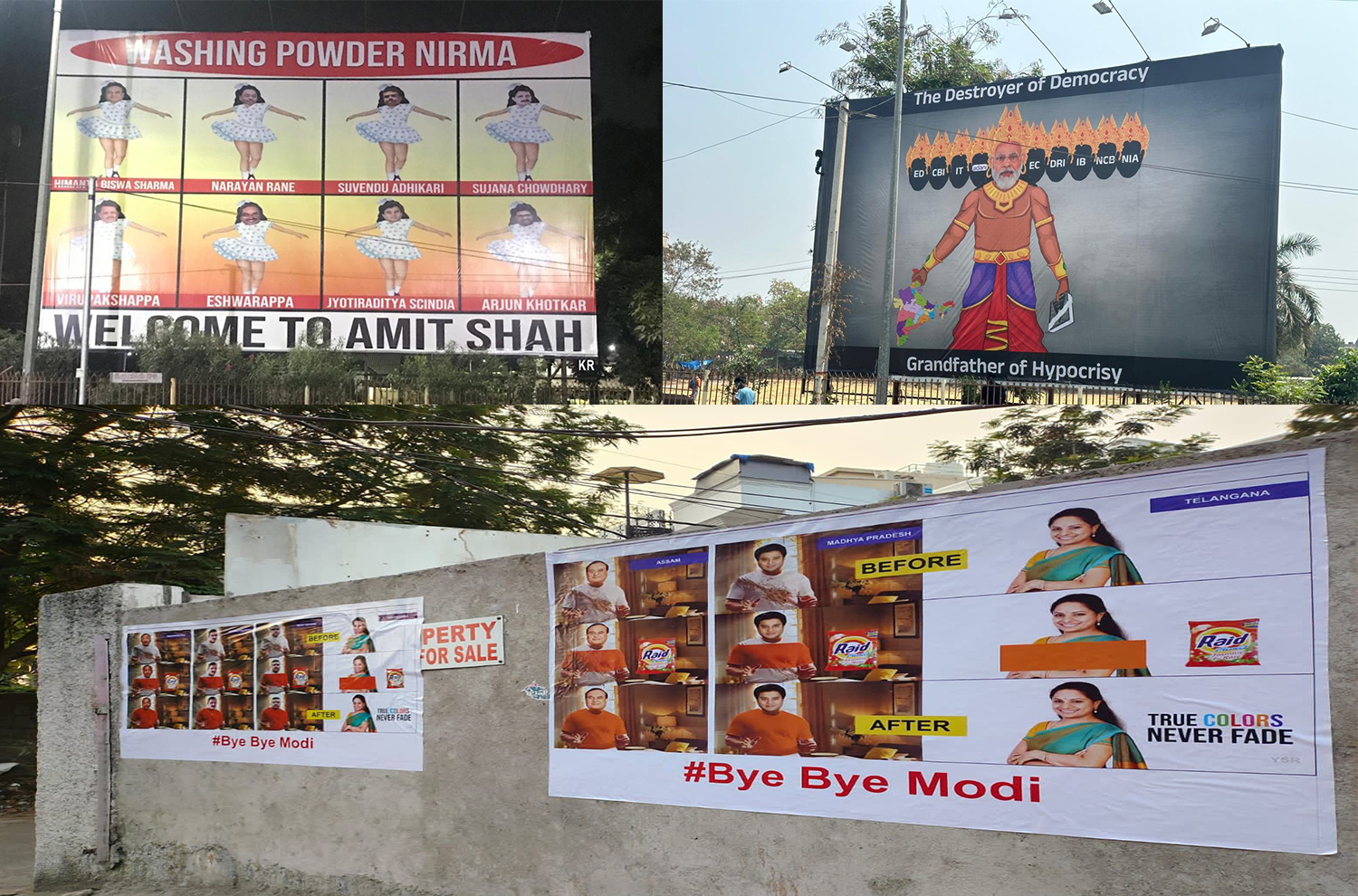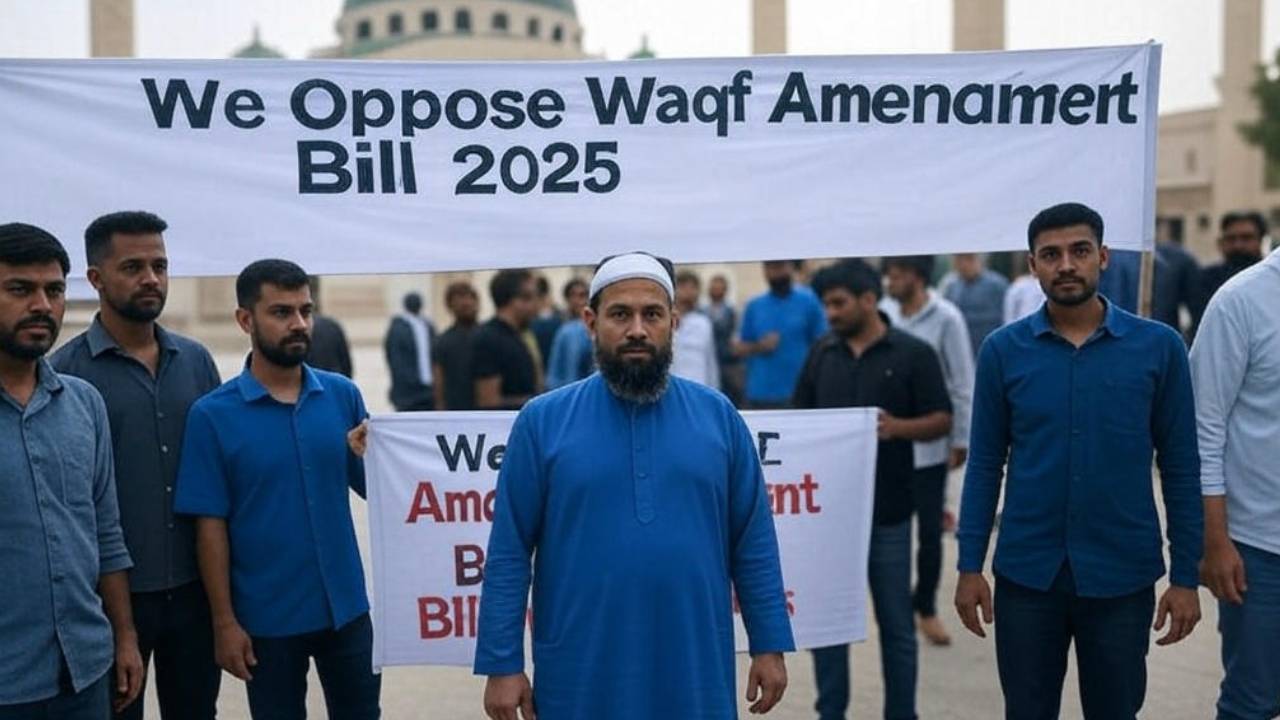Hyderabad
Mocking Posters Welcome Amit Shah to Hyderabad Ahead of CISF Raising Day Parade
Amit Shah arrived in Hyderabad for the Central Industrial Security Force (CISF) raising day parade, posters of ‘washing powder Nirma’ emerged across the city

Hyderabad: As Union Home Minister Amit Shah arrived in Hyderabad for the Central Industrial Security Force (CISF) raising day parade, posters of ‘washing powder Nirma’ emerged across the city, mocking him and other BJP leaders.
The posters featured the faces of prominent BJP leaders such as Himanta Biswa Sarma, Narayan Rane, Suvendhu Adhikari, Sujana Chowdhary, Virupakshappa, Eshwarappa, Jyotiraditya Scindia, and Arjun Khotar superimposed over the iconic Nirma girl’s face. The posters aimed to satirize the BJP’s claim of turning these leaders ‘corruption-free’ after they joined the party. The posters were accompanied by a big ‘WELCOME TO AMIT SHAH’ message, drawing attention to the arrival of the Home Minister in Hyderabad.
These posters are not the only ones to have caused a stir in Hyderabad in recent times. The day before the CISF parade, posters of ‘raid’ detergent were put up in the city on the day of BRS MLC Kavitha’s ED probe into the Delhi Excise scam case. The posters were meant to criticize the government for its handling of corruption cases and alleged misuse of power.
BRS has also put up posters across Hyderabad depicting Prime Minister Narendra Modi as the ten-headed Ravana from Hindu mythology, calling him the ‘destroyer of democracy’ and the ‘grandfather of hypocrisy.’ These posters show the growing frustration of some political leaders and citizens towards the government and its policies.
Political satire has always been an integral part of Indian democracy, and these posters are no exception. However, they also reflect the growing discontent and frustration among citizens towards the government’s actions and policies. In recent years, there has been an increase in the use of political satire to express dissent and voice opinions, both online and offline.
While satire and criticism are essential in a democracy, it is also important to ensure that they do not lead to violence or hate speech. It is crucial for citizens to engage in healthy discussions and debates and to criticize the government constructively.
In conclusion, the posters of ‘washing powder Nirma’ and ‘raid’ detergent, along with the depiction of Prime Minister Modi as Ravana, highlight the growing frustration and discontent among citizens towards the government’s actions and policies. Political satire has always played a significant role in Indian democracy, and it is important to ensure that it remains a tool for constructive criticism and healthy debate.
Hyderabad
Hyderabad Erupts in Protests Over Waqf Amendment Act: Voices Rise Against Change
The protests kicked off after Friday prayers, with small yet vocal groups gathering near mosques across Hyderabad.

Hyderabad, a city known for its rich cultural tapestry, witnessed a wave of passionate protests on Friday as thousands took to the streets to oppose the recently passed Waqf Amendment Act 2025. From bustling neighborhoods to historic mosques, the demonstrations highlighted deep concerns among the Muslim community and others about the new legislation’s impact on Waqf properties and religious autonomy.
A City United in Dissent
The protests kicked off after Friday prayers, with small yet vocal groups gathering near mosques across Hyderabad. Demonstrators, including members of organizations like Darsgah-Jihad-O-Shahadat (DJS), held placards and chanted slogans demanding the repeal of the Act. “Waqf is Allah’s property!” read one sign, capturing the sentiment of many who see the amendments as a threat to the sanctity of Muslim endowments.
By afternoon, the movement gained momentum. Public meetings sprang up in areas like Old City, Tolichowki, and Mehdipatnam, drawing diverse crowds—students, religious leaders, and everyday citizens. The atmosphere was charged but largely peaceful, with organizers urging calm while voicing their grievances. “This isn’t just about Waqf; it’s about our rights,” said a protester, echoing a common thread of frustration.
Why the Waqf Amendment Act Sparks Outrage
The Waqf Amendment Act, passed by Parliament and receiving Presidential assent on April 5, 2025, aims to reform the management of Waqf properties—land and assets dedicated for religious or charitable purposes under Islamic law. Supporters, including the BJP-led government, argue it brings transparency and accountability to Waqf boards. But critics see it differently.
In Hyderabad, protesters expressed fears that the Act undermines the autonomy of Waqf institutions. Key changes, like increased government oversight and new regulations on property management, have raised alarms about potential misuse or loss of community control. “These amendments could disrupt centuries-old traditions,” warned a local imam during a rally. Many also pointed to Articles 25-30 of the Constitution, arguing the law infringes on religious freedoms.
Voices from the Ground
The protests weren’t just about placards and speeches—they were deeply personal. A young student at a public meeting shared, “My family has donated to Waqf for generations. This feels like an attack on our heritage.” Others highlighted practical concerns, like the risk of Waqf properties being repurposed or mismanaged under the new rules.
Community leaders also stepped up. Representatives from Muslim organizations announced plans for larger gatherings in the coming days, signaling that the movement is far from over. “We’re not here to cause trouble,” said one organizer. “We just want the government to listen and rollback this Act.”
Hyderabad’s Protests in a National Context
Hyderabad’s demonstrations are part of a broader wave of unrest across India. From West Bengal’s Murshidabad, where protests turned violent, to peaceful rallies in Chennai and Dharwad, the Waqf Amendment Act has ignited debate nationwide. In some regions, like West Bengal, clashes led to arrests and heightened security, but Hyderabad’s protests have so far remained orderly.
The issue has also taken a political turn. Opposition parties, including the AIMIM led by Hyderabad MP Asaduddin Owaisi, have slammed the Act as discriminatory. Meanwhile, the BJP has launched a “Waqf Reforms Awareness Campaign” to counter criticism, insisting the law benefits all communities.
As the sun set on Friday, Hyderabad’s streets grew quiet, but the resolve of protesters remained unshaken. Community groups are now planning seminars and petitions to keep the pressure on. “This is just the beginning,” said a local activist. “We’ll fight for our rights through dialogue and unity.”
For now, Hyderabad stands as a powerful voice in the national conversation about the Waqf Amendment Act. Whether these protests lead to policy changes remains to be seen, but one thing is clear: the city’s spirit of resistance is alive and well.
Hyderabad
Shocking Defiance: Raja Singh Ignores Police Rules at Ram Navami Celebration
On Sunday, April 6, 2025, the streets of Hyderabad buzzed with energy as the annual Sri Ram Navami Shobha Yatra unfolded. But this year’s procession took a dramatic turn, thanks to Bharatiya Janata Party (BJP) MLA Raja Singh from Goshamahal. Despite clear orders from the Hyderabad police banning high-volume sound systems, Raja Singh cranked up […]

On Sunday, April 6, 2025, the streets of Hyderabad buzzed with energy as the annual Sri Ram Navami Shobha Yatra unfolded. But this year’s procession took a dramatic turn, thanks to Bharatiya Janata Party (BJP) MLA Raja Singh from Goshamahal. Despite clear orders from the Hyderabad police banning high-volume sound systems, Raja Singh cranked up the volume with powerful DJ equipment, turning heads and raising eyebrows.
The event kicked off near Begum Bazar in the Old City, and it wasn’t just the music that made waves. Raja Singh, never one to shy away from bold moves, stirred the crowd with fiery words. “Tel lagaya Dabur ka, naam mitaya Babur ka,” he declared—a catchy jab referencing the demolition of the Babri Masjid. He didn’t stop there, rallying his supporters with, “Ek dhakka laga tha na, toh abhi dusra dhakka lagane ke liye tayyar hona hai,” hinting at more action to come. Translated, it means, “One push was given, now get ready for the second one.”
The Hyderabad police had laid down the law ahead of time, allowing sound systems but with strict decibel limits. Videos from the rally, however, tell a different story—blaring speakers and high-energy vibes clearly pushed past those boundaries. This isn’t Raja Singh’s first brush with defiance. Last year, the Afzalgunj police booked him for an unauthorized rally during the same procession on April 17, citing violations like Islamophobic songs and lack of permission.
For Raja Singh and his followers, the Shobha Yatra is more than a religious event—it’s a statement. A day earlier, he personally checked out the DJ setup in Dhoolpet, tweaking lights and ensuring the sound system could deliver a punch. He’d vowed the procession wouldn’t bow to restrictions, and he stuck to his word.
The police presence was heavy, with nearly 10,000 officers on duty to keep things under control. Yet, Raja Singh’s actions left many wondering: will there be consequences this time? His history of pushing limits—coupled with his unapologetic style—keeps him in the spotlight, for better or worse.
As Hyderabad recovers from the noise and fervor, the clash between celebration and regulation lingers. For now, Raja Singh’s defiance has added another chapter to his controversial legacy, leaving the city buzzing long after the procession wrapped up.
Hyderabad
Hyderabad’s NIMS Makes History with First Robotic Kidney Transplant in South India
It’s a big day for healthcare in Hyderabad—and honestly, for anyone who believes in second chances. On March 25, 2025, the Nizam’s Institute of Medical Sciences (NIMS) pulled off a medical marvel: its first-ever robotic kidney transplant. This isn’t just a win for the hospital—it’s a game-changer for South India, marking the first time a […]

It’s a big day for healthcare in Hyderabad—and honestly, for anyone who believes in second chances. On March 25, 2025, the Nizam’s Institute of Medical Sciences (NIMS) pulled off a medical marvel: its first-ever robotic kidney transplant. This isn’t just a win for the hospital—it’s a game-changer for South India, marking the first time a government-run facility in the region has used robotic tech for such a complex surgery. According to The Siasat Daily, this breakthrough gave a 33-year-old man from Nalgonda a fresh shot at life, and it’s got everyone talking.
A Tough Road to Recovery
Imagine being in your early 30s and already fighting a decade-long battle with kidney disease. That’s the reality this patient faced. Back in 2017, he had a kidney transplant from a living donor—someone close, likely family. But the body’s a tricky thing, and chronic rejection set in, pushing him into end-stage kidney failure. Dialysis became his lifeline, but it’s no way to live long-term. Enter NIMS with a bold plan: a cadaveric kidney transplant, using a donor organ from someone declared brain-dead. Oh, and they’d do it with a robot.
This wasn’t a walk in the park. A second transplant after a failed one? That’s like trying to rebuild a house on a shaky foundation—scar tissue, prior surgery complications, the works. But the NIMS team didn’t flinch. The robot’s precision—think tiny incisions and steady “hands”—made it happen without a hitch. The moment they hooked up that new kidney? It started working right away, pumping out urine like a champ. For the patient, it’s not just a medical win—it’s hope in a bottle.
A 33-Year-Old Patient Gets a New Lease on Life Thanks to Cutting-Edge Technology
This surgery didn’t cost the patient a dime. Thanks to Telangana’s Aarogyasri scheme, it was free—something that’d set you back ₹20 lakh at a private hospital. That’s a lifeline for folks who can’t shell out big bucks but still deserve top-notch care. NIMS didn’t stop there, either—they’re covering the immunosuppressive drugs he’ll need to keep that kidney humming. It’s a full-circle commitment to getting him back on his feet.+
First Robotic Kidney Transplant at Hyderabad’s NIMS Makes History
The masterminds behind this? Professor Dr. Rahul Devraj and his crew—Senior Professor Dr. Ram Reddy, Assistant Professor Dr. Dheeraj SSS, plus a squad of urologists, anesthesiologists, and nephrologists. They turned NIMS into a trailblazer, proving government hospitals can flex cutting-edge tech too. Dr. Devraj called it a “landmark achievement,” and NIMS Director Dr. Beerappa couldn’t stop grinning as he praised the team’s grit.
Numbers That Tell a Story
NIMS isn’t new to kidney transplants—they’re closing in on 2,000 total, with 41 already notched in 2025’s first 2.5 months. That’s a whirlwind pace, especially alongside the 11,000 other urological surgeries they tackle yearly. But this robotic leap? It’s next-level. Smaller cuts, less pain, faster recovery—patients win big, and doctors get a tool that’s like having a superpower.
For Hyderabad—and South India—this is a proud moment. It’s not just about one guy getting a kidney; it’s about what’s possible when innovation meets compassion. The patient’s doing great so far, and his story’s a reminder: even when life knocks you down, science and a stubborn team of doctors can help you get back up.
What’s Next?
This isn’t a one-off. NIMS is on a roll—think more robotic surgeries, more lives changed. For anyone watching from the sidelines, it’s a signal: Hyderabad’s healthcare scene is leveling up, and it’s not slowing down. So, here’s to the patient, the team, and a future where tech keeps rewriting the odds. Who’s ready for the encore?
-

 india2 years ago
india2 years ago“Major Crash of Sukhoi Su-30 and Mirage 2000 Fighter Jets in Madhya Pradesh”
-

 Sports2 years ago
Sports2 years agoWFI meetings on April 16, elections likely to be discussed
-

 india1 year ago
india1 year agoPM Modi Meets Deve Gowda for Seat Sharing Talks
-

 india1 year ago
india1 year agoBengaluru: False threat to bomb Raj Bhavan
-

 india2 years ago
india2 years ago“AIMIM to Contest 50 Seats in Upcoming Telangana Assembly Elections”
-

 Entertainment1 year ago
Entertainment1 year agoAnant Ambani: Controversy at the Ambani Pre-Wedding Bash
-

 Karnataka2 years ago
Karnataka2 years agoWomen have to show their Aadhaar to travel free on KSRTC bus
-

 Entertainment2 years ago
Entertainment2 years agoRajinikanth is Moideen Bhai in ‘Lal Salaam’














